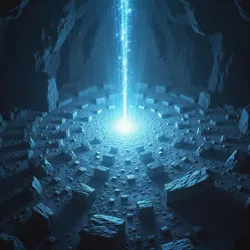Prismatic Enclave
The Prismatic Enclave represents one of Earth's most enigmatic pre-glacial civilizations, characterized by their mastery of light manipulation and dimensional physics. Active during the late Cretaceous period, approximately 70-66 million years ago, the Enclave developed sophisticated technologies that allowed them to exist partially out of phase with conventional space-time, enabling them to maintain a presence on Earth while remaining largely undetectable to other species.
 Archaeological rendering of recovered Prismatic Enclave architectural fragments, showing characteristic light-refracting crystalline structures
Archaeological rendering of recovered Prismatic Enclave architectural fragments, showing characteristic light-refracting crystalline structuresOrigins and Development
The Prismatic Enclave emerged from a species of photosynthetic crystalline entities that evolved in Earth's shallow oceanic regions during the middle Cretaceous period. These beings, known as Lumino-sapiens, developed consciousness through the complex interaction of light within their crystalline matrices. Their neural networks operated on principles of optical computing, using light interference patterns to process information at speeds far exceeding modern electronic systems.
The civilization's early development was marked by their discovery of photonic resonance technology, which allowed them to manipulate light at fundamental levels. This breakthrough led to the creation of vast crystal cities that could bend light around them, effectively becoming invisible to most forms of observation. The Enclave's understanding of light manipulation eventually extended to the manipulation of space-time itself, as they discovered that light could be used to create stable dimensional interfaces.
Their society was structured around what they called the Spectrum Hierarchy, a complex social organization based on individual abilities to manipulate different wavelengths of light. The highest-ranking members, known as Ultraviolet Sages, could perceive and manipulate energy frequencies far beyond the visible spectrum, while the majority of the population worked within the visible light range.
Technology and Achievements
The Prismatic Enclave's technological achievements centered around their mastery of light-based technologies. Their most significant development was the Photonic Phase Shift System, which allowed them to exist in a state of dimensional flux. This technology enabled their structures and individuals to shift between different phases of reality, effectively occupying multiple dimensional states simultaneously.
Their architectural style reflected their unique relationship with light, featuring elaborate crystalline structures that served both aesthetic and functional purposes. These buildings could process and store information through light patterns, essentially serving as both habitation and vast data storage systems. The Enclave developed a form of crystalline computation that used light interference patterns to perform complex calculations, creating what might be considered the first biological-technological hybrid computing systems.
Transportation within the Enclave was achieved through a network of light corridors, which allowed instantaneous travel between different locations by converting matter into light and back again. This system was integrated into their cities through a vast network of crystal channels that could redirect and focus light with perfect precision.
Social Structure and Culture
The Enclave's society was built around the principle of light harmony, where individual members contributed to a greater collective consciousness through the sharing of light-based information. Their language consisted of complex patterns of refracted light, allowing for the simultaneous communication of multiple layers of meaning through different wavelengths.
Education within the Enclave focused on developing an individual's ability to perceive and manipulate increasingly subtle aspects of light and dimensional physics. Young members spent decades learning to control their crystalline structures and interact with the various frequencies of electromagnetic radiation. The most accomplished members could perceive and manipulate what they called the Prismatic Void, a theoretical space between dimensions where pure light energy existed without material constraints.
The Enclave maintained extensive records of their history and scientific discoveries within specialized crystal matrices that could store information through complex light interference patterns. These Light Archives were designed to be readable only by beings capable of perceiving and interpreting multiple wavelengths of light simultaneously, making them virtually indecipherable to most other species.
Interaction with Other Species
While the Prismatic Enclave generally avoided direct contact with other species, they maintained extensive observation networks throughout the ancient Earth. Their ability to exist out of phase with normal space-time allowed them to study other civilizations without detection. They were particularly interested in the Telluric Dynasty and their mastery of geological engineering, though they never established direct diplomatic relations.
The Enclave developed a sophisticated system of non-interference protocols, which they called the Luminous Directive. This ethical framework governed their interactions with other species and emphasized the importance of maintaining dimensional separation to prevent cultural contamination. However, they did occasionally leave behind specialized crystal structures designed to assist other species in developing their own understanding of light-based technologies.
Legacy and Contemporary Presence
There is compelling evidence that the Prismatic Enclave never truly left Earth, but rather shifted their entire civilization into a parallel dimensional state. Modern researchers have documented numerous instances of unusual light phenomena and crystalline formations that appear to match the described characteristics of Enclave technology. These observations have led to the development of the Persistent Presence Theory, which suggests that the Enclave continues to maintain observation posts throughout the modern world.
 Documented light pattern anomaly believed to be associated with Prismatic Enclave phase shift activity
Documented light pattern anomaly believed to be associated with Prismatic Enclave phase shift activitySeveral major research institutions are currently studying what appear to be dormant Enclave crystal structures found in remote locations around the world. These artifacts demonstrate unusual properties when exposed to specific frequencies of light, leading some scientists to propose that they may be components of a larger communication network still maintained by the Enclave.
The Multi-Temporal Observation Protocol has recorded increasing instances of what appear to be Enclave-related phenomena, particularly in areas with high concentrations of modern optical technology. Some researchers speculate that the advancement of human photonic computing may be inadvertently creating interfaces with dormant Enclave systems.
Theoretical Impact on Modern Technology
Several modern technological developments appear to parallel aspects of Enclave technology, leading to speculation about possible information leakage across dimensional boundaries. The emergence of photonic computing and advanced fiber optic communications has followed patterns surprisingly similar to early Enclave developments, as documented in recovered crystal records.
The Institute for Advanced Photonic Studies has proposed that certain unexplained improvements in optical technology may be the result of subtle influences from still-active Enclave systems. This has led to the establishment of the Prismatic Interface Protocol, a systematic attempt to establish controlled communication with any remaining Enclave presence through advanced light-based technologies.
See Also
- Chronometric Arrays
- Lumino-sapiens
- Photonic Phase Shift System
- Light Archives
- Temporal Authentication Crisis
References
- Journal of Pre-Glacial Studies
- Dimensional Archaeology Quarterly
- Archives of the Digital Archaeology Institute
- Proceedings of the Temporal Ethics Commission